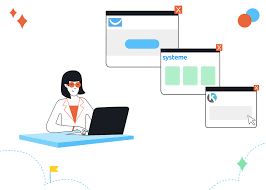Introduction to Solutions Cloud
Cloud solutions refers to a framework that delivers computing resources and services over the internet, facilitating organizations in leveraging technology to enhance their operations. Unlike traditional computing methods, where software and data are stored locally on company servers, solutions cloud utilizes cloud-based infrastructure, allowing for remote access to applications and storage. This fundamental shift has transformed the way businesses operate, providing a wide array of advantages that are increasingly relevant in today’s fast-paced market environment.
One of the primary reasons for adopting solutions cloud is its scalability. Businesses can easily adjust their resources based on fluctuating demands without making substantial investments in physical hardware. This means companies can grow and pivot their operations more swiftly in response to market changes or customer requirements. The flexibility offered by solutions cloud enables organizations to optimize resource utilization, ensuring that they only pay for what they need when they need it.
Cost-efficiency is another significant driver for cloud adoption. By moving to solutions cloud, businesses can minimize capital expenditures associated with purchasing and maintaining hardware. Instead, they can benefit from a pay-as-you-go model, reducing operating costs and allowing for better budgeting and financial forecasting. Moreover, this model often leads to lower IT management costs, as cloud service providers handle maintenance and security, freeing up internal teams to focus on strategic initiatives.
In addition to scalability and cost savings, solutions cloud provides enhanced collaboration capabilities. Teams can access data and applications from various locations, fostering better communication and productivity. As businesses continue to prioritize digital transformation, understanding the scope of solutions cloud becomes increasingly important, as it enables organizations to stay competitive and agile in an ever-evolving landscape.
Table des matières
Benefits of Using Solutions Cloud
The implementation of solutions cloud provides numerous advantages that can significantly enhance a business’s operations and overall efficiency. One of the primary benefits is improved collaboration. With cloud solutions, teams can work together seamlessly, regardless of their physical location. This level of collaboration is particularly critical in today’s rapidly evolving work environment, where remote work and global teams have become the norm. Platforms such as Microsoft 365 and Google Workspace exemplify this, allowing employees to collaborate in real time on documents and projects.
Enhanced security is another vital benefit of adopting solutions cloud. Traditional data storage methods often expose businesses to various vulnerabilities, whereas cloud services utilize advanced cybersecurity measures to safeguard sensitive information. Providers like Amazon Web Services (AWS) and Microsoft Azure adhere to stringent compliance protocols, ensuring that data is protected through encryption and continuous monitoring, thus providing businesses greater peace of mind regarding their data safety.
Increased accessibility is a further benefit that solutions cloud offers. Employees can access necessary information and applications from any device with internet connectivity, eliminating the limitations associated with on-premise solutions. Companies can become more agile and responsive to changing market demands by leveraging this accessibility. A notable example includes Dropbox, which allows individuals and businesses to store, share, and collaborate on files from any location, thereby streamlining workflows.
Finally, utilizing cloud solutions enables businesses to leverage innovative technologies such as artificial intelligence, machine learning, and data analytics. These technologies can help organizations gain valuable insights into their operations, improve decision-making, and enhance customer experiences. For instance, Salesforce harnesses the power of cloud computing to provide businesses with tools for better customer relationship management, ultimately driving growth and success.

Different Types of Solutions Cloud
The concept of Solutions Cloud encompasses various deployment models, each designed to cater to specific organizational needs and use cases. The three primary types of Solutions Cloud are public cloud, private cloud, and hybrid cloud. Understanding these categories is crucial for businesses aiming to leverage cloud technology effectively.
The public cloud is a model wherein computing resources, such as servers and storage, are made available to multiple clients over the internet. Providers like Amazon Web Services and Microsoft Azure manage and maintain the infrastructure, offering scalable and cost-effective solutions. This type is particularly suitable for startups or businesses with fluctuating workloads, as it allows for flexibility and ease of access. However, security concerns can arise since resources are shared among various users, making it less ideal for organizations handling sensitive data.
In contrast, the private cloud is dedicated exclusively to a single organization. This model provides enhanced security and control, as the infrastructure is either managed internally or by a third-party service provider. It is particularly useful for enterprises with strict regulatory requirements or those that require a high level of customization. Although the private cloud offers robust data protection, it usually comes with higher costs, as the organization bears the complete responsibility for the infrastructure.
The hybrid cloud model combines the benefits of both public and private clouds. It enables organizations to manage sensitive workloads in a private environment while utilizing the public cloud for less critical tasks. This approach provides flexibility and scalability, allowing businesses to adapt to changing demands. Nonetheless, the complexity of managing and integrating multiple environments can pose challenges, necessitating a well-planned strategy and strong technical expertise.
Choosing the right type of Solutions Cloud ultimately depends on the specific needs and objectives of the business. Each model offers unique advantages and disadvantages that should be carefully evaluated to ensure alignment with organizational goals.
Key Technologies Driving Solutions Cloud
The efficacy of Solutions Cloud is largely attributed to a combination of advanced technologies that work synergistically to deliver optimal performance and flexibility. Among these key technologies, virtualization stands out as a fundamental element. It enables the creation of virtual instances of hardware resources, effectively allowing multiple operating systems to run concurrently on a single physical machine. This not only enhances resource utilization but also provides businesses with the ability to scale their IT infrastructure seamlessly, adapting to fluctuating demands.
Another significant technology is containerization. Unlike traditional virtualization, containerization encapsulates applications and their dependencies in a lightweight, portable format. This approach ensures that applications perform uniformly regardless of the underlying infrastructure. Consequently, businesses can deploy applications with ease across different environments, whether on-premises or in the cloud. Furthermore, containers streamline the development process by allowing teams to focus on coding rather than environment configurations, thus accelerating the time-to-market for products and services.
Microservices architecture is equally vital in the realm of Solutions Cloud. This methodology structures applications as a collection of loosely coupled services, each of which runs independently and communicates over well-defined APIs. By employing microservices, organizations can develop and deploy applications more flexibly, enabling teams to work simultaneously on different services. This fosters continuous integration and delivery, leading to enhancements in reliability and scalability. As a result, businesses can respond to changes in market conditions more swiftly and efficiently.
In essence, the interplay of virtualization, containerization, and microservices forms the backbone of Solutions Cloud. These technologies not only enhance cloud performance and flexibility but also empower organizations to innovate rapidly while managing costs effectively. Understanding these foundational elements is crucial for businesses aiming to leverage the full potential of Solutions Cloud in today’s dynamic digital landscape.

Challenges of Implementing Solutions Cloud
The implementation of solutions cloud can present a range of challenges that organizations must navigate to achieve a successful transition. One of the foremost concerns is data security. As businesses increasingly rely on cloud computing for storing sensitive information, they may become vulnerable to cyberattacks. Protecting data from unauthorized access requires robust security protocols and vigilant monitoring. Companies must invest in encryption technologies and robust identity management systems to safeguard their data, ensuring that they comply with industry standards.
Compliance is another critical area of concern. Organizations often face regulatory requirements that dictate how data is managed and protected, and these may vary significantly by industry and region. Ensuring compliance with standards such as GDPR or HIPAA while utilizing cloud services can be complex and resource-intensive. Businesses must engage in thorough due diligence when selecting cloud providers, ensuring that they adhere to the necessary regulations and facilitate easy compliance reporting.
Vendor lock-in is another challenge that organizations may encounter. Once they have integrated a particular cloud service provider, migrating to another platform can be difficult and expensive. This risk reinforces the importance of strategic planning when selecting cloud solutions. Organizations should consider multi-cloud or hybrid cloud strategies that allow for better flexibility and interoperability between different service providers, mitigating the risks associated with vendor lock-in.
Lastly, the complexities of migration cannot be overlooked. Transitioning existing systems and data to a cloud environment requires meticulous planning and execution. Businesses may encounter compatibility issues or data integrity challenges during the migration process. To alleviate these difficulties, establishing a clear migration strategy and conducting thorough testing prior to full deployment is crucial.
In addressing these multifaceted challenges, organizations can better position themselves for a more seamless and effective integration of solutions cloud into their operational frameworks.
Case Studies on Successful Solutions Cloud Implementation
The implementation of solutions cloud has transformed various organizations across different industries, allowing them to enhance operational efficiency, reduce costs, and improve service delivery. In this section, we will explore several case studies that illustrate successful cloud adoption and the benefits it brings to businesses.
One noteworthy case is that of a leading healthcare provider that faced challenges with data management and patient information accessibility. Before implementing a solutions cloud, this organization struggled with fragmented data systems and outdated technologies, which hindered their ability to deliver timely and effective care. After a thorough evaluation, the organization decided to transition to a cloud-based system, allowing for centralized data storage and real-time access to patient information across departments. The outcome was significant; not only did patient care improve, but the organization also reported a 30% reduction in operational costs, showcasing the effectiveness of adopting solutions cloud in the healthcare sector.
Another relevant case involves a global retail company that needed to enhance its inventory management process. Prior to implementing solutions cloud, the company dealt with issues of overstocking and stockouts, which directly affected sales and customer satisfaction. By adopting a cloud-based inventory management system, the retailer was able to achieve better visibility into stock levels and demand forecasting. This led to more efficient supply chain operations and a 25% increase in sales due to improved product availability. The case exemplifies the strategic advantage of embracing solutions cloud for optimizing inventory management.
These case studies highlight that successful solutions cloud implementation often requires a deep understanding of the organization’s specific challenges and goals. By carefully selecting cloud solutions tailored to their needs, businesses can realize substantial benefits, paving the way for future innovations and growth.
Future Trends in Solutions Cloud
The solutions cloud landscape is rapidly evolving, driven by technological advancements that offer new opportunities for businesses. One significant trend is the integration of artificial intelligence (AI) and machine learning (ML) into cloud services. These technologies enhance automation, enabling businesses to analyze vast amounts of data more effectively, predict customer behaviors, and optimize operational processes. As AI continues to be incorporated into solutions cloud, businesses can expect more tailored experiences and intelligent applications that adapt based on real-time data.
Another prominent trend is the rise of serverless computing. This paradigm minimizes the need for traditional server management by allowing developers to run applications without provisioning or maintaining servers. Instead, cloud providers manage the infrastructure, automatically scaling resources according to demand. This allows businesses to focus on writing code and deploying applications quickly while benefiting from cost savings and improved scalability. As serverless computing gains traction, it will likely reshape how companies approach their cloud architecture.
Moreover, edge computing is becoming increasingly critical in the solutions cloud ecosystem. By processing data closer to the source, such as IoT devices, edge computing reduces latency, ensuring faster response times and improved performance. This trend is particularly advantageous for businesses that rely on real-time data processing and need immediate insights. As more data is generated at the edge, the collaboration between solutions cloud and edge computing will further streamline operations and enhance the user experience.
Collectively, these trends signify that the future of solutions cloud will not only revolve around more intelligent, responsive applications but also foster a more efficient operational framework for organizations. The convergence of AI, serverless computing, and edge computing paints a promising picture for the accessibility and functionality of cloud solutions, equipping businesses to thrive in an increasingly digital environment.
Best Practices for Choosing a Solutions Cloud Provider
When selecting a solutions cloud provider, several best practices should guide the decision-making process to ensure that the chosen provider aligns with business needs and objectives. One of the primary considerations is the provider’s security measures. In an era where data breaches are increasingly common, it is essential to evaluate the security protocols of potential providers, such as data encryption, multi-factor authentication, and regular security audits. A robust security framework not only protects sensitive information but also builds trust with customers.
Another critical factor to assess is compliance certifications. Different industries are subject to various regulations that mandate specific data handling practices. Therefore, the ideal solutions cloud provider should possess relevant certifications, such as ISO 27001, GDPR compliance, or HIPAA compliance, depending on your industry. These certifications demonstrate the provider’s adherence to established standards and can help mitigate legal and financial risks associated with non-compliance.
Support services also play a vital role in selecting a solutions cloud provider. Businesses should investigate the availability of technical support, response times, and whether support is offered 24/7. Reliable customer service can significantly reduce downtime during critical situations and enhance overall operational efficiency.
Furthermore, scalability options are essential when evaluating solutions cloud providers. As businesses grow, their cloud services must evolve to accommodate increased data storage and processing needs. Providers that offer flexible scalability options, such as pay-as-you-go pricing models or customizable resource allocation, can help businesses manage costs while ensuring they have the necessary infrastructure to support growth.
Lastly, it is beneficial to conduct thorough research and comparisons of different providers. Customer reviews, case studies, and service level agreements (SLAs) can provide insights into the strengths and weaknesses of various providers, facilitating a more informed decision-making process that aligns with the organization’s strategic goals.
Conclusion and Future Outlook
In conclusion, the Solutions Cloud offers a transformative landscape for businesses striving for efficiency, innovation, and scalability. By integrating cloud technologies into their operations, organizations can enhance their performance, streamline processes, and improve overall agility. The discussed points underscore the versatility of the Solutions Cloud, which caters to various industries and business sizes, enabling a tailored approach to fulfilling specific operational needs.
As businesses continue to adapt to evolving market dynamics, the importance of a robust cloud strategy cannot be overstated. With advancements in artificial intelligence, machine learning, and data analytics, companies that leverage the Solutions Cloud are better positioned to harness insights, optimize decision-making, and ultimately enhance customer experiences. The cloud provides unparalleled resources that facilitate collaboration and drive innovation, thereby creating sustainable competitive advantages.
Looking ahead, the future of business operations is likely to be heavily influenced by the ongoing development of cloud technologies. Organizations should consider investing in multi-cloud strategies to ensure flexibility and reduce dependency on a single provider. This not only mitigates risks but also enables businesses to choose the best solutions suited to their unique requirements. Moreover, as regulatory frameworks and compliance requirements evolve, having a proactive cloud management approach will be essential for maintaining security and operational integrity.
Ultimately, the Solutions Cloud represents a strategic investment in the future of business. By embracing these technologies, companies can not only enhance their current operational capabilities but also drive innovation and growth in an increasingly digital world. As we move forward, the integration of Solutions Cloud will be pivotal in shaping the direction and success of businesses across various sectors.

